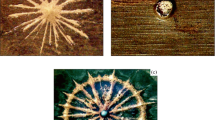Abstract
It is well known that a vacuum arc discharge operating at nearly threshold currents is unstable and features short-time (10–7–10–8 s) voltage and current bursts. We were the first to detect under these conditions bursts of the electron current from the cathode in the circuit of a collector located normal to the discharge axis and having a considerable (up to ∼1 kV) electron-retarding potential with respect to the cathode. It has been revealed that the most intense and high-energy electron flows are formed as an arc discharge re-ignites after its extinction. These flows are to a large measure responsible for the current transfer between the electrodes at this time and are not local jets in character. It has been shown that the mechanism for the generation of intense radially accelerated electron flows from the cathode is related to the formation of nonstationary double layers between the near-cathode and near-anode plasmas and to the rapid decrease in near-anode plasma potential upon re-ignition of an arc. This concept offers an adequate description of the duration of electron current bursts at the collector and the electron energy spectrum obtained experimentally by the method of retarding potentials.
Similar content being viewed by others
REFERENCES
C. W. Kimblin, J. Appl. Phys., 44, 3074–3081 (1973).
Z. Zalucki and J. Kutzner, in: Proc. VIIth Int. Symp. Discharges and Electrical Insulation in Vacuum, Novosibirsk, USSR, 1976, pp. 297–302.
W. M. De Cock and J. E. Daalder, Ibid., pp. 288–292.
H. C. Miller, J. Appl. Phys., 43, 2175–2181 (1972).
R. P. P. Smeets, J. Phys. D: Appl. Phys., 19, 2401–2413 (1986).
V. I. Baryshnikov and V. L. Paperny, Ibid., 28, 2519–2521 (1995).
N. I. Vogel, in: Proc. XVIIIth Int. Symp. Discharges and Electrical Insulation in Vacuum, Eindhoven, The Netherlands, 1998, pp. 202–206.
A. V. Batrakov, S. A. Popov, and D. I. Proskurovsky, Prib. Tekh. Eksper., 2, 104–108 (1996).
G. A. Mesyats, Zh. Tekh. Fiz., 44, 1521 (1974).
G. A. Mesyats and D. I. Proskurovsky, Pulsed Electrical Discharge in Vacuum, Springer, Berlin–Heidelberg (1989).
I. G. Kesaev, Cathode Processes in Electric Arcs [in Russian], Nauka, Moscow (1968).
D. I. Puchkarev and D. I. Proskurovsky, Zh. Tekh. Fiz., 51, (1981).
C. W. Mendel and S. A. Goldstein, J. Appl. Phys., 48, 1004–1006 (1977).
H. F. Ivey, Adv. Electron. Electron Phys., 6, 137–256 (1954).
Author information
Authors and Affiliations
Rights and permissions
About this article
Cite this article
Batrakov, A.V., Popov, S.A. & Proskurovsky, D.I. Formation of Accelerated Electron Flows under the Conditions of a Pulsed Low-Current Vacuum Discharge. Russian Physics Journal 43, 747–753 (2000). https://doi.org/10.1023/A:1009427903065
Issue Date:
DOI: https://doi.org/10.1023/A:1009427903065



